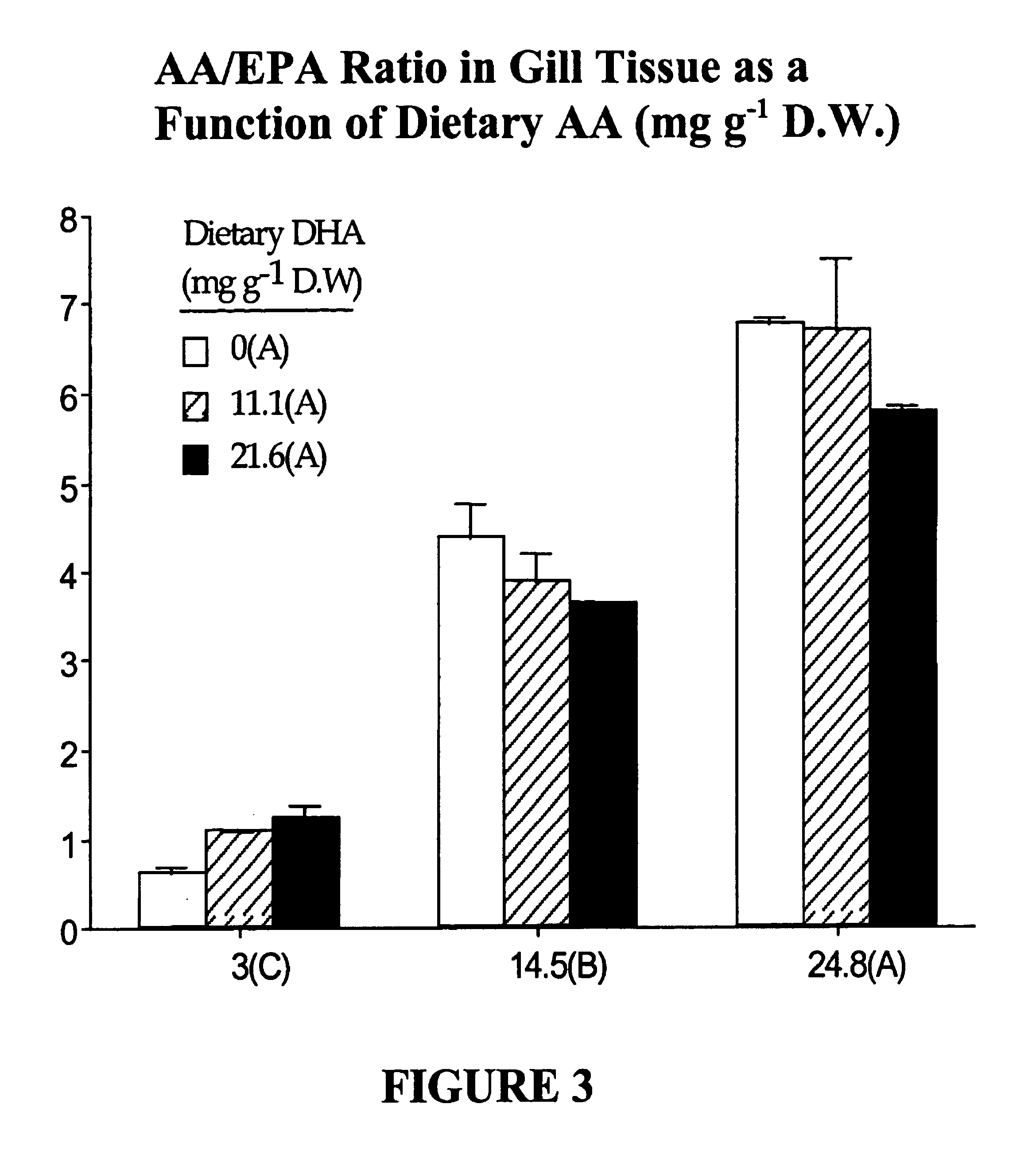Use of arachidonic acid for enhanced culturing of fish larvae and broodstock
a technology of arachidonic acid and fish larvae, which is applied in the field of use of arachidonic acid, can solve the problems of antagonistic relationship, which is potentially detrimental to the proper function of brain and neural tissues, and the mortality of fish larvae is frequent, so as to reduce the level of whole body cortisol, and enhance the stress resistance of fish larvae
- Summary
- Abstract
- Description
- Claims
- Application Information
AI Technical Summary
Benefits of technology
Problems solved by technology
Method used
Image
Examples
example 1
Larval Rearing
[0057]Newly hatched striped bass (M. saxatilis) larvae were obtained from the Aquaculture Research Center (ARC) of the Center of Marine Biotechnology (COMB), University of Maryland. Larvae were raised for 17 days post hatching on rotifers, Bracionus plicatilis (2-5 rotifers ml−1), which were grown separately on fresh-water Chlorella sp. paste (0.5 g / 106 rotifers / day, obtained from Martek BioSci. Inc. Columbia, Md.).
[0058]Seventeen days post-hatched larvae were randomly distributed in eighteen 60-liter rearing tanks at an initial density of 160 larvae per tank. The rearing tanks were gently aerated and the water volume exchanged 1-2 times per day with biofiltered, UV treated recirculating water. A 14:10 h light:dark photoperiod cycle was maintained using fluorescent lights (Daylight; 40 watts; 800-1200 lux at the water surface). Temperature was maintained at 24±2° C. and salinity at 2-6 psu. Water quality was monitored daily, and levels of total NH3, unionized N-3, NO2 ...
example 2
[0107]In this example, we examined the extent to which extreme nutritional levels of DHA or AA or a combination of both would modulate lipid composition in larval tissues, in order to establish the combined nutritional requirements for both DHA and AA. The animals used in this study were metamorphosed white bass larvae (day 24-46), which were at a sensitive developmental stage in which high mortality generally occurs during normal culturing.
Materials and Methods
[0108]Formulation of enrichment emulsions. A 3×3 factorial design (two factors, DHA and AA at nine different combinations in duplicate blocks) was used to simultaneously study the effect of increasing dietary levels of DHA and AA on larval performances. Nine different emulsions having varying proportions of DHA-rich triacylglycerols from heterotrophically grown algae, Crypthecodinium spp. and AA-rich triacylglycerols from fungus, Mortierella spp. (DHASCO and ARASCO, Martek BioSci. Columbia, Md.) were formulated (Table.2). Tri...
example 3
[0147]In this example, the use of heterotrophically grown microalgae and its extracted oil was evaluated as a source of nutrients and essential fatty acids for live food and in formulated broodstock feeds in aquaculture. These heterotrophically grown microalgae and extracted oil sources are particularly rich in docosahexaenoic acid (DHA) and arachidonic acid (AA), and may be utilized for enhancing larval growth and survival, as well as contributing to egg and sperm quality when included in broodstock diets.
Materials and Methods
Algal Sources
[0148]Heterotrophicaly grown algal based materials included; spray-dried preparations of whole cell (WC-Cr), defated cells (DC-Cr), DHA rich triacylglycerols (TAG-Cr) and phospholipids (PL-Cr) extractions of Crypthecodinium sp., whole cells (WC-CO) of Chlorella s., and AA-rich phospholipids extract (PL-Mo) of the fungi, Mortierella sp. All these materials were obtained from Martek Bioscience Corp. (Columbia, Md.). Lipid and fatty acid compositions...
PUM
| Property | Measurement | Unit |
|---|---|---|
| body weight | aaaaa | aaaaa |
| body weight | aaaaa | aaaaa |
| dry weight | aaaaa | aaaaa |
Abstract
Description
Claims
Application Information
 Login to View More
Login to View More - R&D
- Intellectual Property
- Life Sciences
- Materials
- Tech Scout
- Unparalleled Data Quality
- Higher Quality Content
- 60% Fewer Hallucinations
Browse by: Latest US Patents, China's latest patents, Technical Efficacy Thesaurus, Application Domain, Technology Topic, Popular Technical Reports.
© 2025 PatSnap. All rights reserved.Legal|Privacy policy|Modern Slavery Act Transparency Statement|Sitemap|About US| Contact US: help@patsnap.com



